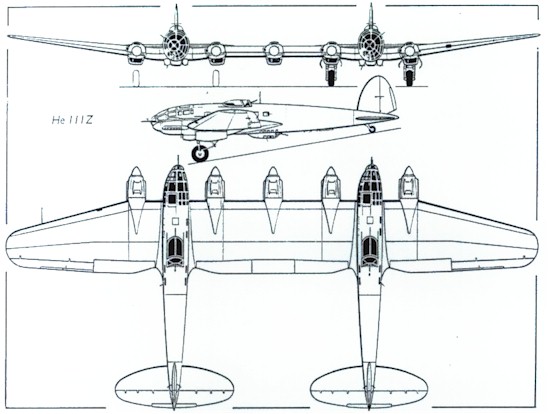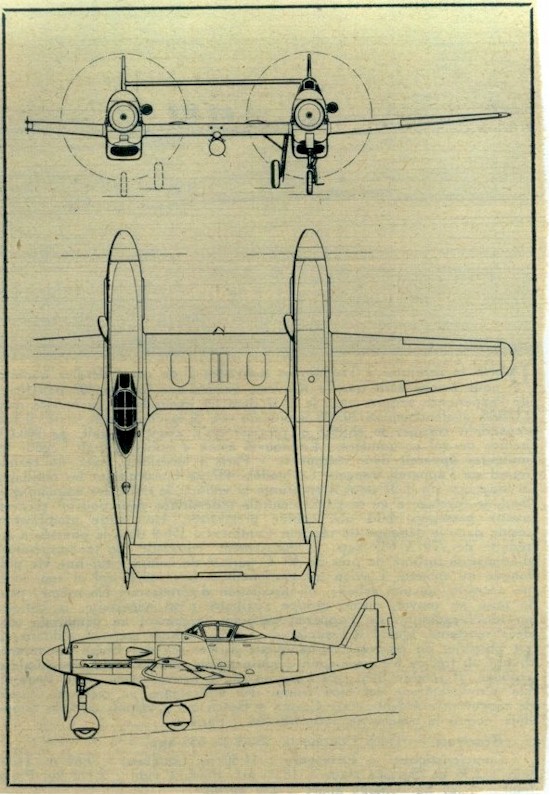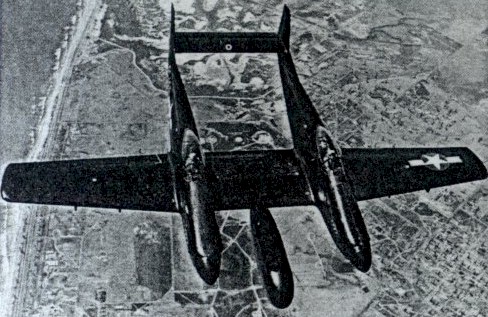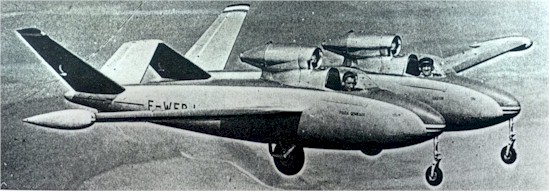| Although not very known, twins have been flying since 1915. The first was a design, named M9 or K1 (Kampfflugzeug), by the Dutchman Anthony Fokker. He lived at that time in Germany. |
||||||||||||||||||||||||||||||||||||||
Fokker used two M7 fuselages and mounted them together to form the M9. The M7
was a biplane. On the outsides he placed the original wings and between both fuselages he
placed a new wingsection as upperwing. The lowerwing was a combination of a wingsection
and a short fuselage. This new fuselage had the original engines of both M7's. One was
mounted in the front and one in the back driving a pusherprop. Twins aren't always a failure.
|
||||||||||||||||||||||||||||||||||||||
|
||||||||||||||||||||||||||||||||||||||
In World War II the Germans made a huge glider, the Messerschmidt Me 321 (see
Giants). It was so large and heavy that 3 twin-engine Bf 110 fighters had to be used
together to tow the glider in the air. These triple tows or "Troika-Schlepps"
were very dangerous to all planes involved. The He 111 Z was operational since the summer
of 1942, but all the planned operations were cancelled due to not obtained strategic goals
like necessary captured airstrips. Their first operation was to deliver Me 321's filled
with supplies to the troops in Stalingrad. Bad weather and in-between landings on
overcrowded airfields delayed the flights and when they reached Makeyevka it was too late.
Another German twin was the Messerschmidt
Me 609. It was formed by two Me 309-fighters. The Me 309 was intended as a replacement for
the Me 109, which had no longer a superior performance in relation to the Allied fighters
like the Supermarine Spitfire. It also lacked the necessary range. But the Me 309
development did progress very slow.
I would like to thank a person with callname "NiteWolf" for giving me the data on the Me 309.
|
||||||||||||||||||||||||||||||||||||||
|
||||||||||||||||||||||||||||||||||||||
* 'Combat Aircraft of world war Two' written by Elke C. Weal, John A Weal and Richard F. Barker. with Editorial Consultant J. M. Bruce and written in co-operation with the RAF Museum in Hendon." P51+P51=F82.
Maths by a mad teacher? No no, just a description of another twin. During WW II the
Mustang or P51 was known for its longer range. It could escort bombers to Berlin. But these
flights were very long and a fighterpilot couldn't count on a co-pilot to prevent fatique.
A tired pilot could make wrong and lethal decisions when encountering a enemy.
North American Aviation did propose a simple solution. A twin-version of the Mustang. Why not? It could be constructed in limited time because the P-52 tools could be used. Some changes had to be made. The original wings had to be reinforced, a new tailplane and a new undercarriage was made. The port cockpit had all flight and engine controls, while the other cockpit only had enough controls to land the plane in a emergency or to let the co-pilot fly while the pilot takes a rest (or nap).
|
||||||||||||||||||||||||||||||||||||||
|
||||||||||||||||||||||||||||||||||||||
| The F-82
came too late to play a role in WW II. Only 20 of the proposed serie of 500 F-82's were
completed before VJ-Day (day of Japanese surrender). Even thought all production of
non-jet powered aircraft stopped, some types were important enough to be used in the
post-war plans of the USAF. The F-82 was one of them. When the North Korean Army crossed the 38th Parallel into South Korea, the Korean War began. The only fighter to be able to depart from the American bases in Japan and have sufficient range to make sorties over Korea was the Twin Mustang. It was a F-82 who shot down the first enemy airplane, a Yak 11, a trainer who tried to get a shot at another F-82. The F-82 could carry a pod under the midsection. This pod could house a additional six guns (never used in operations) or a radar. The black painted F-82G with its huge central radar pod was the most known version of the F-82. Its operational career ended in 1953. The reason for the very long pod can be found in the interference of the props. To keep the radar free of this interference it had to placed before the props. A very long pod was the solution. If there is one airplane that could deserve the name Chameleon it would be the Piper Cub. The Cub has been changed in its history to many new needs. I have no idea what need did lead to the next variant of the Cub.
|
||||||||||||||||||||||||||||||||||||||
|
||||||||||||||||||||||||||||||||||||||
If you
say to yourself: "Hey, those props are too close to each other!", well, I did
too. But if you look at the picture closely you will see that there is more shadow to the
left of the right prop. I think that the right prop is placed a bit further forward than
the other. This way they can turn without tearing each other apart.
Another twin I found was the Fouga C.M. 88-R "Gemeaux" (Twin). It is a twin version of the Fouga C.M. 8 Cyclope. It uses its fuselages, its typical V-shaped tails and the outer wings. They made a new wing section between both fuselages and made a connection under the tails (it is just visible on the frontal picture). This twin was a testbed for the light Turboméca jet engines. |
||||||||||||||||||||||||||||||||||||||
|
||||||||||||||||||||||||||||||||||||||
|
||||||||||||||||||||||||||||||||||||||
My opinion about twin: hmmm....seeing these examples I think that twins were only used as hasty solutions for a typical temporary problem. Assembling a twin was done much faster than designing a completely new airplane and making the necessary tools and rigs. But they also had some disadvantages. The F-82 had two single cockpits. The co-pilot couldn't help the pilot if he got shot. He could only fly the F-82 to the nearest base. Once there the first aid could be done... maybe too late. The He 111Z had twice the internal volume of the H111. But I bet that a new freighter with the same total volume could carry larger parts. Just look at the Super Guppy (see "Giants"). A wider fuselage gives the possibility to load larger parts. Imagine if they would even have used the He 111Z as a bomber. It would be a BIG problem if one fuselage had a release problem during the bombing. The asymetrical load would flip the airplane on its back.
Another similar project was the Arado P530 (go see www.luft46.com) . It enhances two newly designed fuselages. But this project got cancelled because it had no advantages when compared to the H 111 Z. It even had disadvantages, due to the fact that the H 111 Z had very few new parts, most were stock H 111 parts. I guess that this would have killed all the Fauvel asymmetrical proposals before they left the drawingboard. |
||||||||||||||||||||||||||||||||||||||





